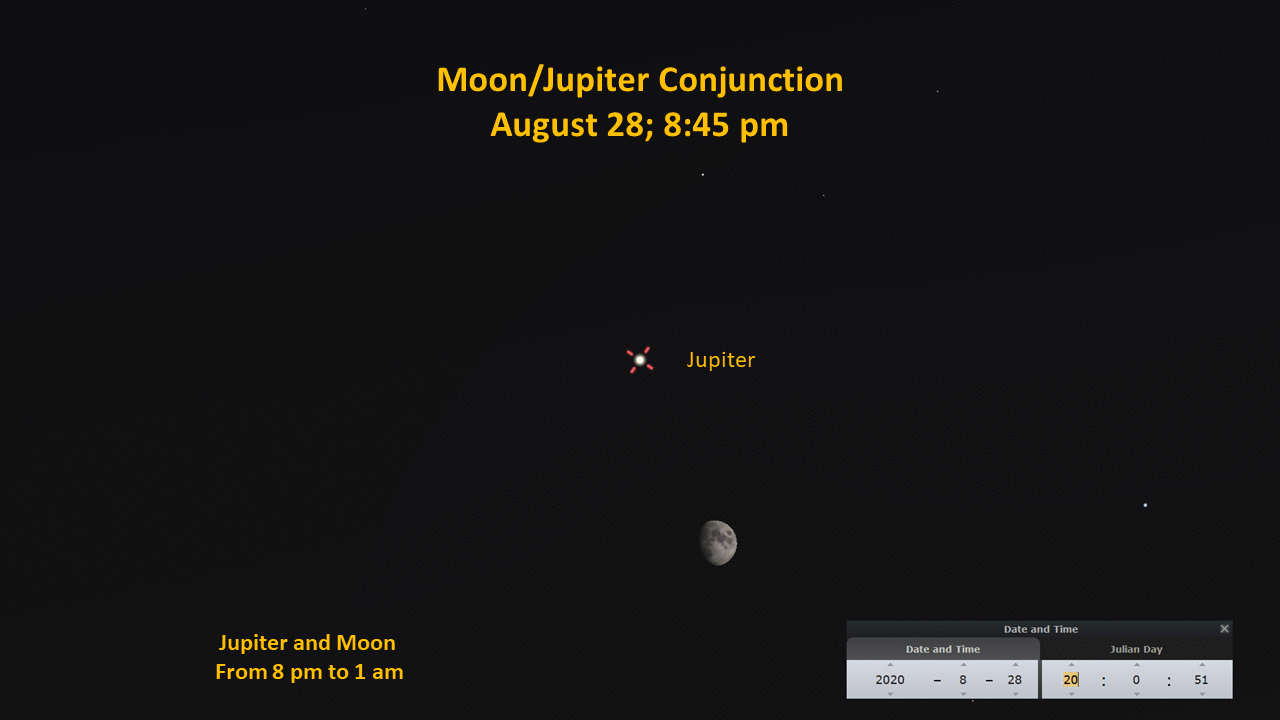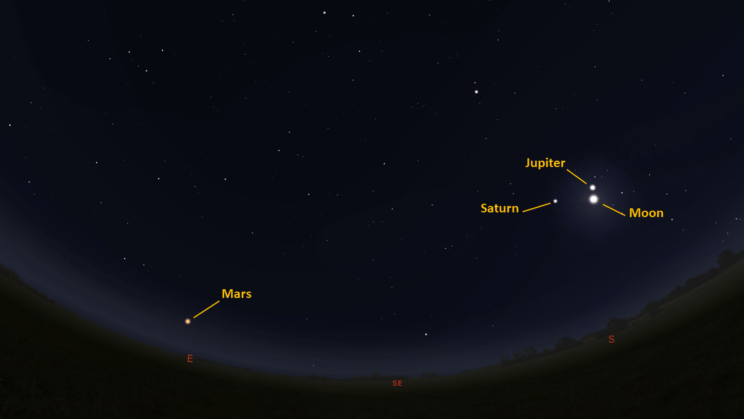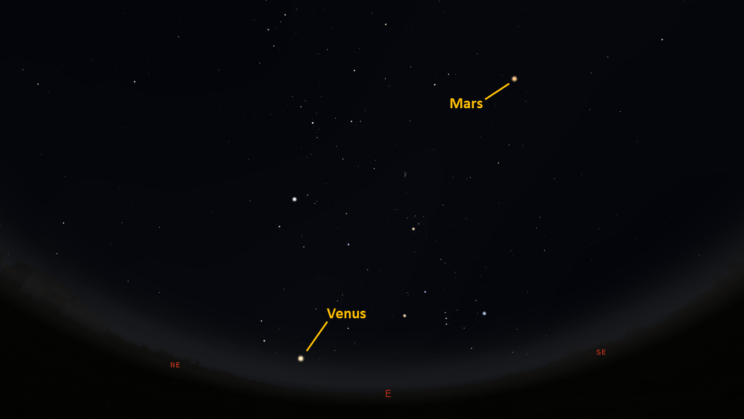This is the Saint Louis Science Center’s NIGHT SKY UPDATE for the week of Friday, August 28, 2020.
Information updated weekly or as needed.
Times given as local St. Louis time (CDT). For definitions of terminology used in the night sky update, click the highlighted text.
Public Telescope Viewings
Star parties at the Saint Louis Science Center have temporarily been canceled due to recommendations from the CDC regarding COVID-19. All public telescope events are canceled until further notice. As conditions change, we will reevaluate and update this article once public observing events resume.
Observing Highlight of the Week

Simulated view of Moon and Jupiter Conjunction August 28, 2020
Credit: Stellarium, EG
This week the Moon and Jupiter will reach conjunction. This occurs on August 28 at 8:35 p.m. As the sky darkens you will find the Moon and Jupiter in the south. Once in conjunction, the Moon and Jupiter will be seen a mere 1.4° apart. Each month the Moon passes by all of the planets as it completes its orbit. When the Moon and a planet share the same right ascension, they are in conjunction.
Viewing these events is a great way to learn about how humanity developed astronomy. Today conjunctions may not offer much scientific insight, but it is these kinds of events that inspired ancient observers to study the skies. Next week we will see an even better conjunction with the Moon and Mars. Learn more about This week’s Moon and Jupiter conjunction here.
The Sun and Moon

The Moon as seen from the International Space Station, on July 31, 2011.
Credit: NASA
Sunrise is at 6:27 a.m. on Friday, August 28 and sunset is at 7:36 p.m. providing us with a bit over 13 hours of daylight. Even after sunset, the light from the Sun will dimly illuminate our sky for about 1 hour and 40 minutes. This period is called twilight, which ends around 9:10 p.m. this week. For those with a sundial, local noon occurs around 1:02 p.m. this week.
| Day | Sunrise | Sunset |
|---|---|---|
| 2020-08-28 | 6:27 a.m. | 7:36 p.m. |
| 2020-08-29 | 6:28 a.m. | 7:35 p.m. |
| 2020-08-30 | 6:29 a.m. | 7:33 p.m. |
| 2020-08-31 | 6:30 a.m. | 7:32 p.m. |
| 2020-09-01 | 6:31 a.m. | 7:30 p.m. |
| 2020-09-02 | 6:32 a.m. | 7:29 p.m. |
| 2020-09-03 | 6:33 a.m. | 7:27 p.m. |
| 2020-09-04 | 6:33 a.m. | 7:26 p.m. |
| 2020-09-05 | 6:34 a.m. | 7:24 p.m. |
Moon
Moonrise for Friday, August 28 occurs at 5:04 p.m. and moonset will occur at 2:37 a.m. on the following day. On Friday, August 28 the Moon will exhibit a waxing gibbous phase with about 87% of the lunar disk illuminated. Full moon occurs on September 2 at 12:22 a.m.
International Space Station (ISS) Observing

Visible passes of ISS from St. Louis for the week of August 28 occur during morning hours. The best pass this week occurs on August 29. Use the table below for information about this and other visible passes this week.
Catch ISS from St. Louis starting Friday, August 28
| Date | Starts | Max. altitude | Ends | |||||||
|---|---|---|---|---|---|---|---|---|---|---|
| Time | Alt. | Az. | Time | Alt. | Az. | Time | Alt. | Az. | ||
| 29 Aug | -1.1 | 03:51:39 | 19 | ENE | 03:51:39 | 19 | ENE | 03:52:47 | 10 | ENE |
| 29 Aug | -1.9 | 05:24:36 | 14 | WNW | 05:26:30 | 21 | NNW | 05:29:09 | 10 | NNE |
| 30 Aug | -2.4 | 04:38:53 | 30 | NNW | 04:38:53 | 30 | NNW | 04:41:43 | 10 | NNE |
| 31 Aug | -1 | 03:53:07 | 19 | NE | 03:53:07 | 19 | NE | 03:54:13 | 10 | NE |
| 31 Aug | -1.2 | 05:26:49 | 10 | NW | 05:28:24 | 13 | NNW | 05:29:59 | 10 | NNE |
| 01 Sep | -1.4 | 04:40:16 | 16 | NNW | 04:40:29 | 16 | NNW | 04:42:39 | 10 | NNE |
| 02 Sep | -0.7 | 03:54:26 | 14 | NNE | 03:54:26 | 14 | NNE | 03:55:15 | 10 | NNE |
Magnitude (Mag): The Measure of brightness for a celestial object. The lower the value is, the brighter the object will be.
Altitude (Alt): The angle of a celestial object measured upwards from the observer’s horizon.
Azimuth (Az): The direction of a celestial object, measured clockwise from an observer’s location with north being 0°, east being 90°, south being 180° and west being 270°.
For information about ISS flyovers and other visible satellites, visit www.heavens-above.com
Detailed information regarding all unmanned exploration of our universe, missions past, present, and planned, can be found at Jet Propulsion Laboratories:
The Visible Planets

Looking Southeast, at 10:30 pm, August 28, 2020
Credit: Stellarium, EG

Looking East, 3:30 am, August 29, 2020
Credit: Stellarium, EG
This week, four naked eye planets are visible. Jupiter and Saturn rise before sunset. Look for them in the south once it is dark. Mars rises in the late evening and will be best seen after midnight. Venus can be found in the eastern sky before sunrise.
For those tracking Jupiter and Saturn as they approach their great conjunction later this year, the two gas giants currently appear about 8.36° apart in the sky. Jupiter appears to be moving away from Saturn right now due to retrograde motion. This is all an illusion caused by Earth passing by slower moving Jupiter. Saturn is also exhibiting retrograde motion. If you keep watching these planets as 2020 progresses, you will see some interesting behaviors that inspired early astronomers to track the skies.
Venus
Venus is well into another morning apparition. After months of seeing Venus in the west after sunset Venus is now visible in the east before sunrise. Venus rises at 2:53 a.m. and will be easily seen by 3:45 a.m. Venus remains a morning object until March 26, 2021 when it reaches superior conjunction. Since Venus has passed greatest western elongation, it will start to exhibit a gibbous phase.
Mars
The red planet rises around 9:51 p.m. and will be high enough to see in the southeast by 10:45 p.m. Opposition for Mars occurs on October 13, 2020. As we head towards this date Mars will appear brighter and larger through a telescope improving surface details. Surface features are already visible when viewing conditions are favorable. Current apparent brightness of Mars is -1.7 magnitude. At this magnitude Mars will appear brighter than any star in the night sky.
Jupiter
Look for Jupiter in the southeast about 30 minutes after sunset. Jupiter will set at 2:27 a.m. Those with a telescope can enjoy views of Jupiter’s cloud features and the Great Red Spot when it is pointed towards Earth.
Saturn
Look for the ringed planet in the southeast about 30 minutes after sunset. Saturn sets at 3:08 a.m. For those with a telescope keep track of the orientation of Saturn’s rings. Since Saturn is tilted on its rotational axis, we cross the plane of Saturn’s ring every 13 to 15 years. We are headed towards another ring plane crossing on March 23, 2025. Over the next five years you will notice Saturn’s rings will gradually incline towards an edge on appearance.
2020 Great Conjunction
This year the planets Jupiter and Saturn will reach conjunction. A conjunction is when two or more celestial bodies share the same right ascension. For Jupiter and Saturn this astronomical event occurs every 20 years. The conjunction occurs on December 21, 2020. You will find the two planets close together in the southwest just after sunset on this date.
Visit the James S. McDonnell Planetarium for more information on what’s up!
Night Sky Update: August 28-September 4, 2020






